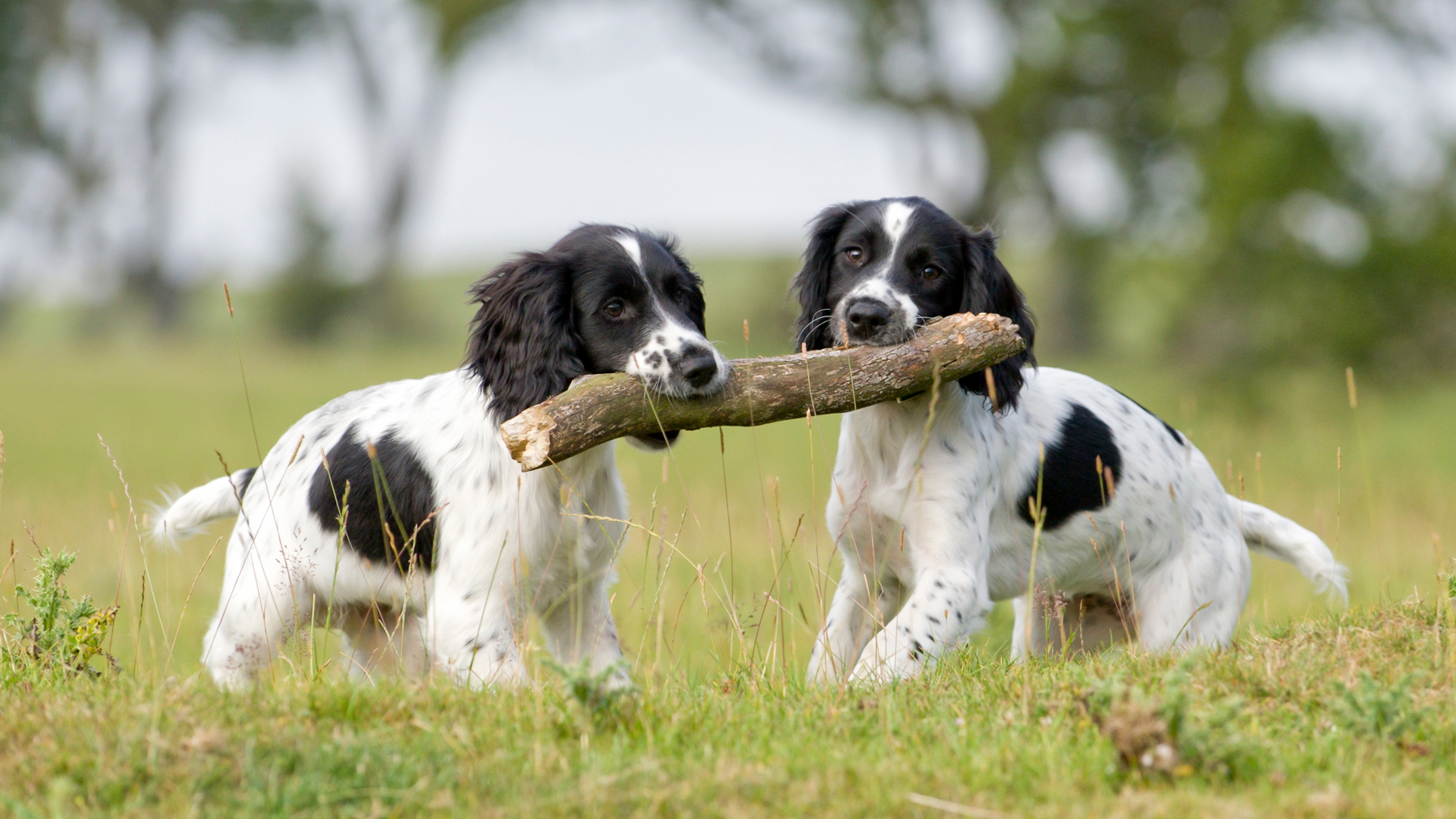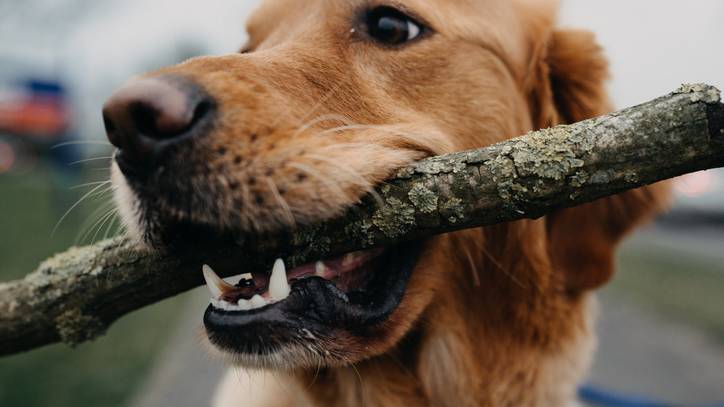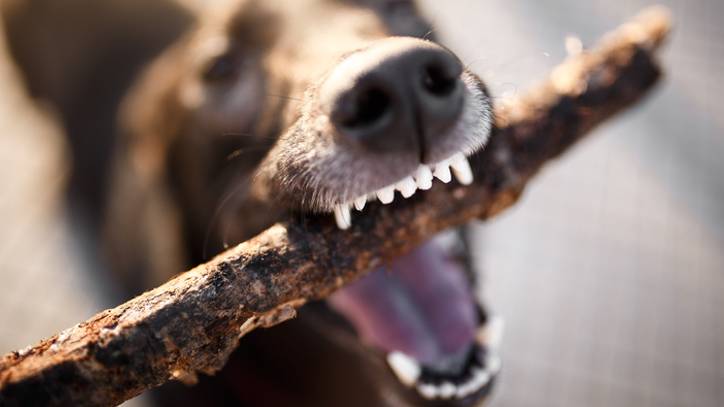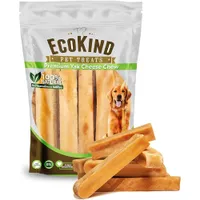Can dogs eat sticks? Vet’s advice on risks, alternatives, and prevention
Can dogs eat sticks? We chatted with an expert vet about the risks and alternatives you can choose to prioritize your dog’s health and well-being.

Dogs famously love to chase and chew on sticks, but what happens if they take it a step further — can dogs eat sticks?
While technically dogs can (and will) eat anything they feel like, the real question here is “can dogs safely eat sticks”? There may be no more iconic image than a dog with a stick in their mouth, but sadly there are several reasons why you shouldn’t let your pooch eat sticks. Dogs chewing on sticks can lead to splinters or other damage to their mouth or intestinal tract, and bits of the stick can become a choking hazard if they break off.
Throwing sticks for your dog can also be dangerous, as you can end up hitting them as they try to catch it — stick to safer options from our best dog toys list. If they really want to eat what they catch, you can also look at using the best long lasting dog chews.
It can be tough to recognise the signs a dog is in pain, even for the most caring pet owners, so if your dog has been playing with sticks, make sure you give them a thorough check over and keep an eye on them for signs of distress or injury.
We spoke to expert vet Dr Joanna Woodnutt about why you should avoid throwing sticks for your dog, the potential dangers of stick ingestion, and ways you can teach your dog to avoid eating sticks.

Dr Joanna Woodnutt graduated as a veterinarian from the University of Nottingham in the United Kingdom in 2016 and went on to practice companion animal medicine in the Midlands. She quickly developed a love of consulting and helping clients with medical problems such as dermatology, behavior, and nutrition. Dr Woodnutt now lives in the Channel Islands with her husband Ian, their daughter, and their terrier Pixie.
Why do dogs eat sticks and leaves?
You might be wondering why a dog would want to eat a stick or leaves. After all, they may be omnivorous but their appetites usually lean towards the carnivorous end of the scale. There are a couple of reasons why dogs eat sticks and leaves:
- They are responding to the natural instinct to chew.
- The sticks and leaves may have been covered in something ‘tasty’, like bird poop or dropped human food.
- The leaves may be rotting and producing a pleasant smell that might entice your dog to try them.
- Your dog may be suffering from a condition called ‘pica’ — a condition that causes them to crave eating non-food items.
You’ll probably know just from reading which of these is likely in your pup. Perhaps you have a teething puppy and they seem to eat everything in sight.
Get the best advice, tips and top tech for your beloved Pets
Or maybe your older dog has been under the weather and now seems to be eating unusual objects, making you suspect pica as a cause. In some cases, however, you might never find out why your dog has taken to eating sticks and leaves.

Is it safe for a dog to chew on sticks and leaves?
So, it’s fairly common, but is it safe? Well, unfortunately, most vets definitely wouldn’t recommend you let your dog play with sticks on a regular basis.
When your dog chews on sticks, they risk pieces of the stick breaking off and causing damage in their mouths. Fragments of broken stick can get stuck between the gums and teeth, wedged in the roof of the mouth, or cut the tongue or cheeks.
Another risk of your dog eating leaves and sticks is fungal poisoning. Some types of mould that grow on dead vegetation can be toxic to dogs. And of course, the leaves or twigs themselves can be poisonous if they come from toxic plants. So, it’s generally best to discourage your dog from eating sticks and leaves.
What happens if a dog eats a stick?
If your dog doesn’t just chew the stick but actually swallows it, you may also worry about whether the stick is safe to eat. Unfortunately, sticks will not be digested by your dog so any swallowed sticks could cause a hazard or a blockage.
If a dog has eaten a stick, any bowel obstruction can be especially dangerous – broken sticks can be sharp and may pierce the gut (a bowel perforation). Lastly, sticks that get through the gut may cause uncomfortable constipation.
Signs your dog has eaten a stick
Thankfully, many dogs that eat sticks will get away without being any worse for their choice in snack!
However, if your dog has eaten a stick, you should keep an eye out for signs of gut pain, including vomiting and adopting the ‘prayer position’ – this can indicate a gut blockage and should be investigated immediately.
When to visit your vet
Whilst you don’t need to rush your dog to the vet for eating a stick, there are some times when a vet visit will be necessary. You should call your vet if:
- You notice any signs of gut obstruction
- Your dog is bleeding from their mouth after eating a stick
- Your dog is pawing at their mouth or showing other signs of irritation
- Your dog appears to be choking
- Your dog is straining to defecate but not producing feces
Should you stop your dog eating sticks and leaves?
Ideally, your dog wouldn’t eat sticks and leaves – it’s an unnecessary risk. However, it can be hard to stop them. Wherever possible, try to prevent your dog from eating sticks and leaves. This might involve using a muzzle in the autumn when there are leaves on the ground and training your dog to ‘leave’ on command.
How to stop your dog eating sticks
It’s all very well saying you should stop your dog eating sticks and leaves but how do you do it? Well, it can be tough – after all, the urge to chew is strong!
One good option is to redirect their chewing instinct onto safe chew toys. Just like stopping a puppy chewing, you should give them plenty of suitable chew toys and praise them for using them.
A strong ‘leave’ command will also come in very useful if your dog is prone to eating everything when you’re outside. Rewarding them with the best dog treats when they drop the stick will reinforce the behavior and give them something else to chew on too.
You may find it helps to pick up sticks in the garden in the short term whilst you’re training your dog, to reduce the number they find.
Puzzle toys can also amuse dogs and help to prevent boredom, which can cause destructive behaviors like chewing.

So, if you’re asking “can dogs eat sticks?” the answer is “not really”. Sticks can’t be digested by dogs and may risk a blockage as well as damage to the mouth, teeth, gums, and digestive tract.
If your dog just ate a stick, don’t panic. Unless they’re bleeding from the mouth or in distress it’s likely they’ll be fine. Keep a close eye on them and discourage them in future.
And lastly, remember never to throw sticks for your dog - they can cause severe damage and even death.
So, we know what happens when a dog eats a stick. But can dogs eat bones? Find out here.
EcoKind Pet Treats Premium Yak Chew
$23.95 from Amazon
Made with 100% Yak milk, these all-natural chew sticks are a healthy and delicious treat for dogs. Much tastier and better for them than those nasty sticks they keep dragging around.
After graduating as a vet from the University of Nottingham in 2016, Dr. Joanna Woodnutt went on to practice companion animal medicine in the Midlands. She quickly developed a love of consulting and helping clients with medical problems such as dermatology, behavior and nutrition - anything that involved helping clients understand their pets better.
Jo started writing about pet health in 2017, realizing that it meant she could help even more pet parents. Since then, she has written for countless online and print publications and is a regular contributor for Edition Dog Magazine. Jo is the director of The Veterinary Content Company, which she founded in 2020. She is also the founder of Petlearnia, a platform that provides pet e-learning courses for pet parents.
Jo now lives in the Channel Islands with her husband Ian and terrier Pixie.
- Jessica DowneyFreelance Writer

